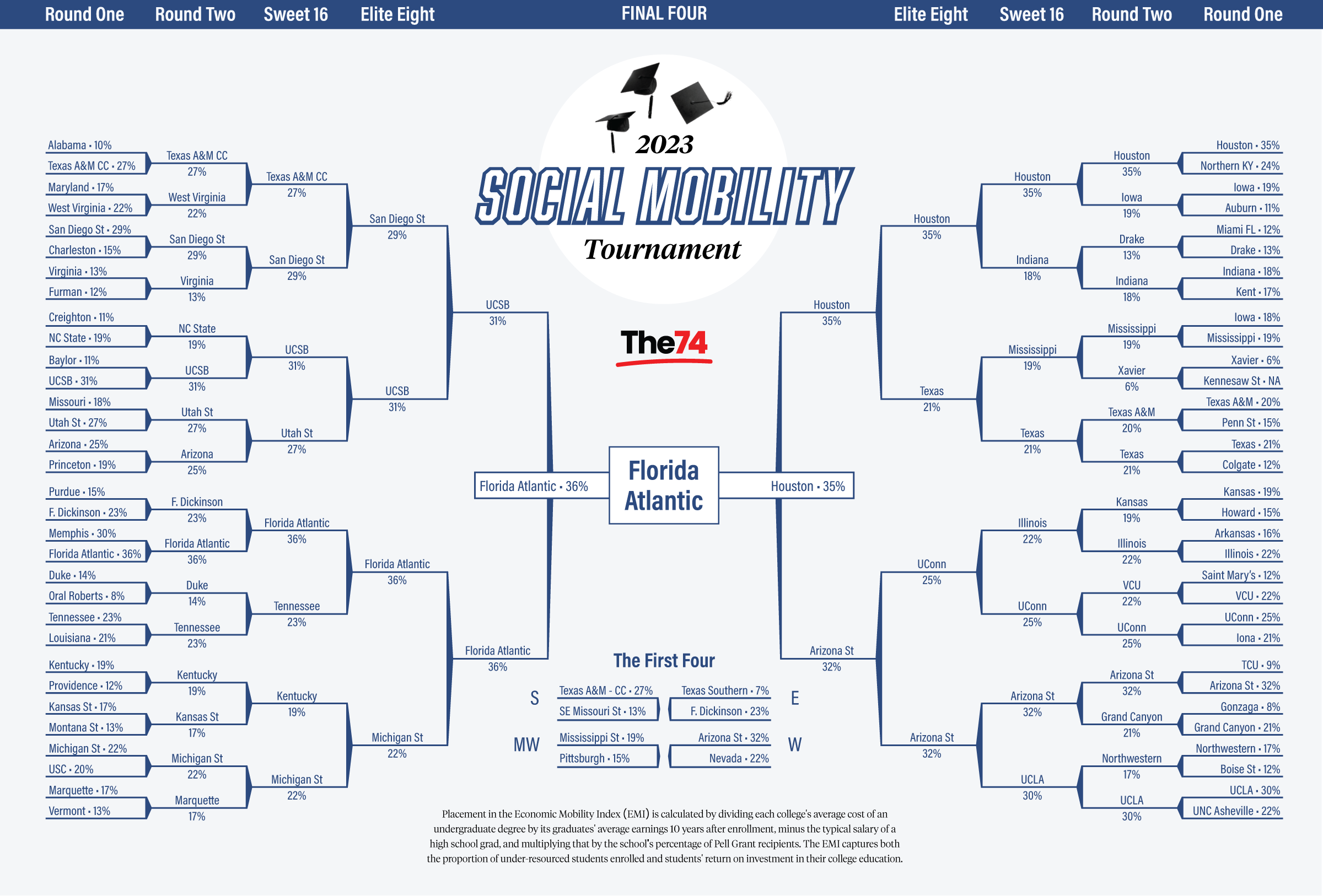If March Madness Were about Social Mobility, We’d Be Cheering Florida Atlantic U
Which NCAA men's basketball tournament schools are best at giving students income mobility and a good return on investment? Check out our bracket!
By Jorge Klor de Alva | March 15, 2023Updated
Once again, March Madness has taken hold of much of the nation as this month’s NCAA men’s Division I basketball tournament gets off the ground. As we have done over the past six years, we take this opportunity, when the nation is focused on figuring out which colleges produce the best basketball teams, to examine which of the participating schools are the best at preparing their students for life beyond college.
We undertake this exercise by creating a parallel bracket — the Social Mobility Tournament Bracket — that plots the colleges invited to the Big Dance by how well or how poorly they help their students reach the American Dream of upward mobility.
For most middle-class, traditional-aged college students, life after graduation can be a very scary time. If they have ended their studies, their scheduled and predictable life is abruptly interrupted by the start of an uncharted trajectory of adult responsibilities. Given that fewer than one senior in 75 playing in the tournament will be lucky enough to be drafted by an NBA team, this applies as well to most of the athletes eager to show their skills on the court this month.
For low-income students, often racial or ethnic minorities and frequently the first in their families to go to college, the challenges can be far greater. Consequently, while all schools are responsible for equipping their students with the skills, habits and knowledge they will need to have rewarding careers after graduation, those institutions serving low- and moderate-income students have an even greater obligation to make sure they are doing the right thing.
Schools that do well for their students should be recognized as true champions; colleges that fail to do so should be pointed out as needing improvement. It is with that mission in mind that each year we have created a parallel bracket of winners and losers, where economic mobility, rather than prowess on the court, is celebrated.
In years past, we have used the Harvard-based Opportunity Insights dataset to spotlight the extent to which disadvantaged students enrolled in the tournament’s colleges have managed to reach family-sustaining earnings by their early 30s. In particular, each school has been mapped on a bracket where winners and losers are determined through a mobility rate that represents the percentage of students born to parents in the bottom 40% of income distribution who reach earnings in the upper 40% of household income.
While this comparison of achievement across generations has been useful, growing concern around college access, affordability and post-collegiate earnings has called for more comprehensive tools by which to understand the value of college for individuals and the nation. Consequently, beyond how well or how poorly schools help make intergenerational advancement possible, today it is important to know which colleges are worth their tuition cost in time and money; how long a student will have to work to pay off that cost; and what proportion of each college’s less-resourced students is being placed on the path to financial security.
With that in mind, we have used a new dataset for this year’s Social Mobility Tournament Bracket. This dataset was developed and analyzed by Michael Itzkowitz, former director of the U.S. Department of Education’s College Scorecard. With these data, he created Third Way‘s Economic Mobility Index (EMI) that ranks 1,320 bachelor’s degree-granting institutions by how well each provides economic mobility for its students.
Itzkowitz used publicly available information from the U.S. Department of Education and the Census Bureau to ascertain each college’s rank on the index. First, he determined the return on investment that lower-income students obtain at each of these 1,320 colleges, by calculating the out-of-pocket costs required to obtain a four-year degree. The EMI then considers the additional financial benefits students obtain by attending one of these schools. This earnings premium is defined as the additional income these graduates make in comparison to someone with only a high school diploma. In sum, the lower the out-of-pocket costs and the higher the earnings premium, the quicker a student will receive a return on the investment needed to obtain the degree.
The EMI also considers the proportion of lower- and moderate-income students a college enrolls. If the school provides a very strong ROI to lower-income students, but enrolls mostly students from upper-class backgrounds, it cannot be said to be doing a good job at providing economic mobility. Therefore, the EMI also rewards schools for the proportion of lower- and moderate-income students it enrolls in addition to the ROI it provides them.
In effect, this year, we are taking into consideration not only the percentage of students who move up the economic ladder, but also the size of the group of low- and moderate-income students a school places on the escalator to a better life. In doing so, colleges that rank highly in our updated bracket may be quite different from those that in the past would have made it to the Final Four and beyond.
For example, the Final Four in last year’s Social Mobility Tournament Bracket were Marquette, Providence, Notre Dame and Bryant. Compared with the other schools in the 2022 tournament, these had the highest percentages of students who climbed to the top 40% in earnings though their parents were in the lowest 40% of income. This feat is certainly admirable. But taking into consideration the relatively small number of low-income students who out-earned their parents, we find that these schools have had a very small impact as social mobility promoters. In fact, their EMI rank, respectively, is 558th, 844th, 925th and 1020th out of the 1,320 institutions in the index.

As the parallel bracket shows, of the 32 teams making it past the first round, 27 are public colleges and universities. These are the workhorse schools providing students with many of the services and programs that can best lead to widespread upward mobility. And chief among their virtues is the reasonable net cost for their degrees, hovering on average around $39,000.
That leaves us with a Sweet Sixteen composed only of public colleges, the best of which make for an Elite Eight with EMI scores averaging 28.9% and all with an EMI rank above 346.
The Final Four in this year’s Social Mobility Tournament Bracket have EMI rankings worthy of detailed attention. The Houston Cougars — seeded No. 1 in the Midwest Region — have an impressive EMI score of 34.9% while ranking 67th in the index. Cougars can take pride in the fact that it takes them less than two years to earn the cost of their degree. Meanwhile, the Sun Devils at Arizona State, ranked 95th, on average pay back their undergraduate degree in a mere 1.2 years — and they do it with about 36% of their undergraduates on Pell Grants. UC-Santa Barbara’s Gauchos are not far behind, with a 106th ranking and a payback period of 1.6 years, and all while serving a student body where over a third are Pell Grant recipients.
That brings us to this year’s national champion, Florida Atlantic University. At 36%, the school has the highest EMI score among the tournament’s participants and ranks 63rd of the 1,320 colleges in the sample. This means two important things: On average, Florida Atlantic Owls take only one year to pay down the total net cost of their degree, and this feat is accomplished with an undergraduate population of nearly 39% low- to moderate-income students.
All in all, these winners in the race to provide the most mobility to the greatest number of students are worth celebrating and supporting no matter how well or poorly their teams may perform in the NCAA tournament. Colleges like these represent not only the best hope for tens of thousands of today’s most challenged students, but also the best answer for a nation hoping to prepare its residents to compete in a progressively polarized world.
Get stories like these delivered straight to your inbox. Sign up for The 74 Newsletter

